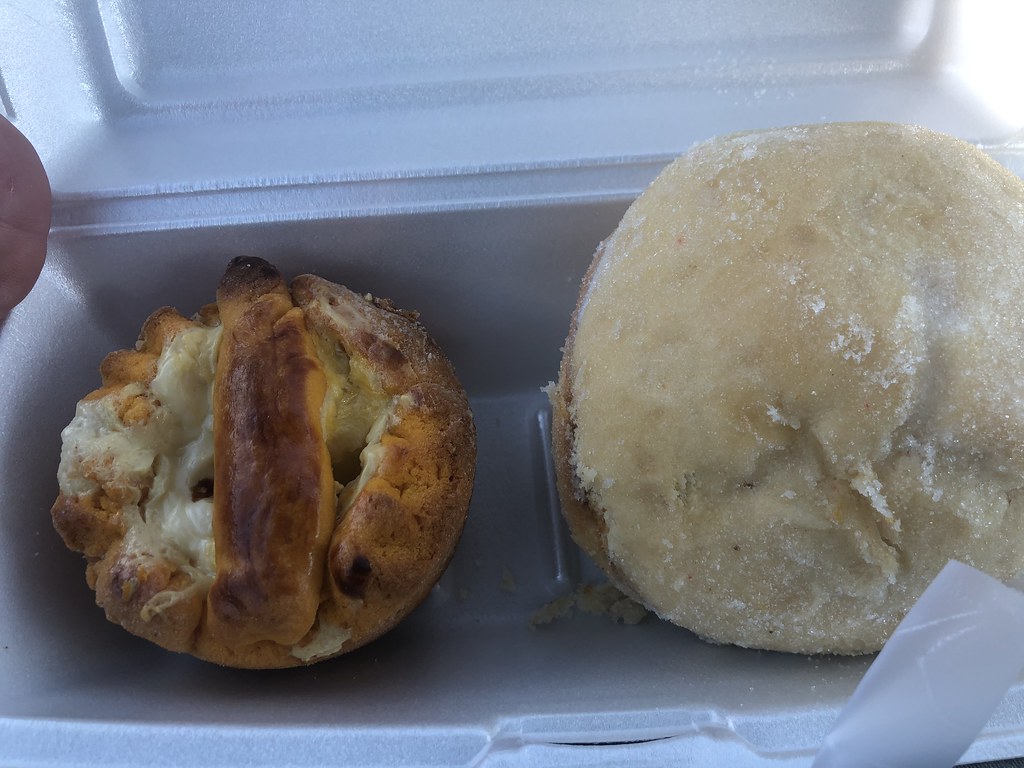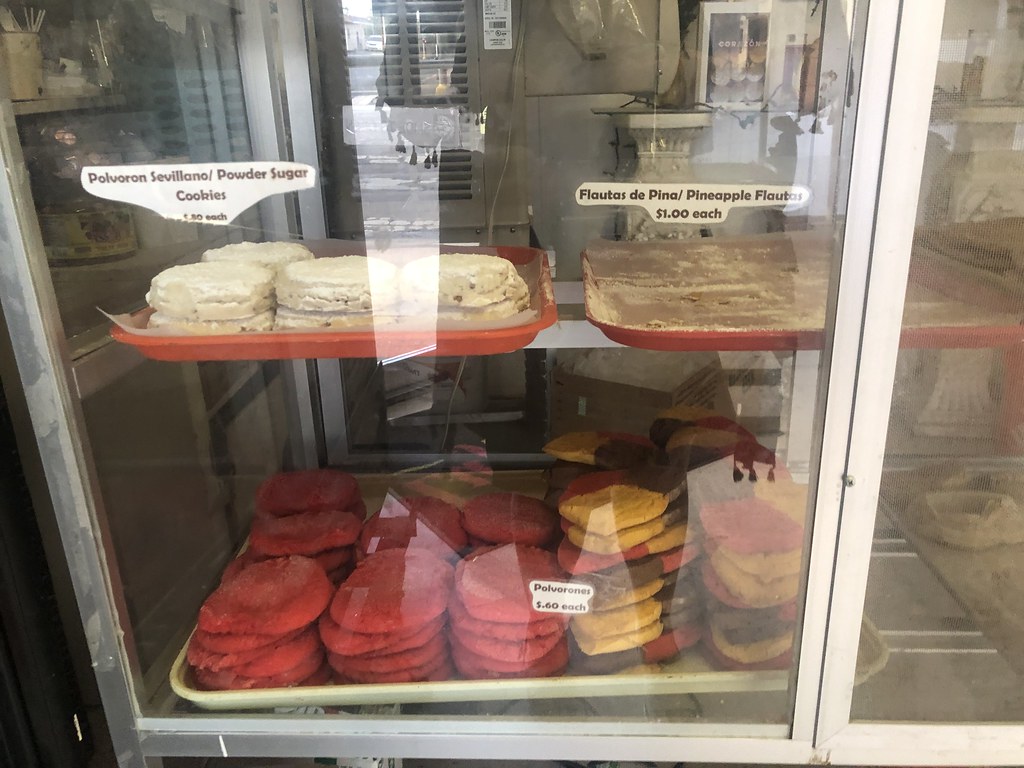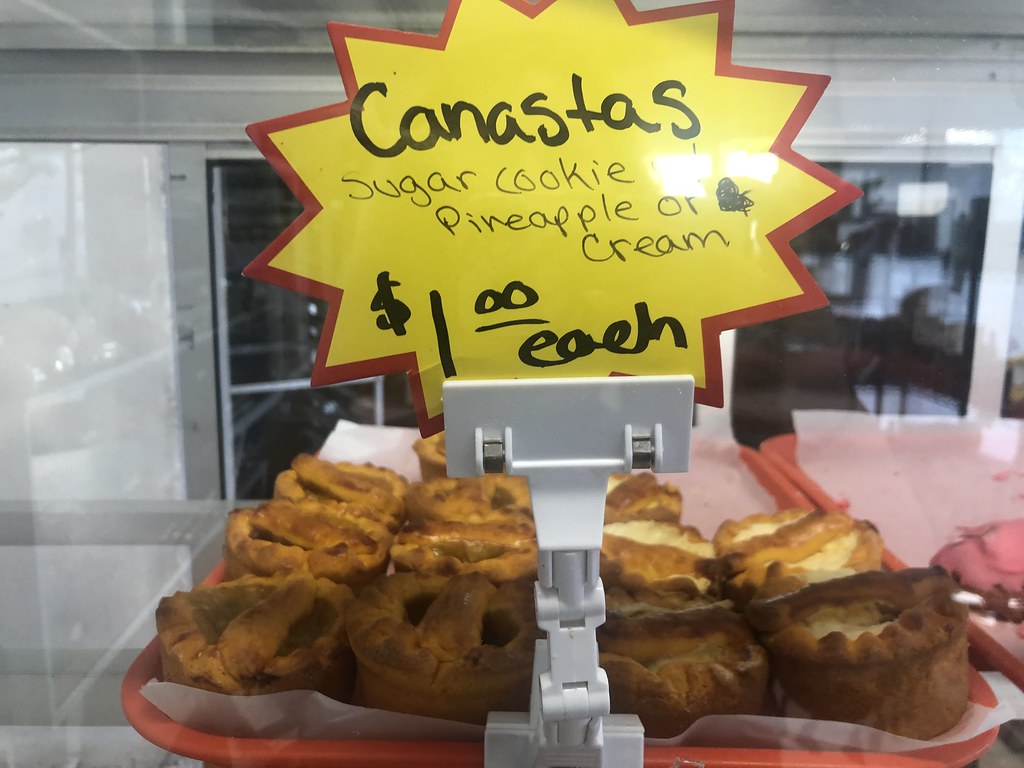
Lujan Bakery is one of the oldest bakeries in town and offers traditional Mexican baked goods.

"Some of the most popular items at Lujan’s Bakery include the marranitos (Mexican gingerbread pigs), empanadas, and the pan de huevo (Mexican sweet bread)," according to this article.

I had to try a little bit of everything because it was all so new to me! The gingerbread pigs, the conos de cherry, the canastas, the yoyos mantequilla, polvorones...

I think the canastas were my favorite. They're like sugar cookies with pineapple filling inside. They are like little mini pies in bite-size form.

The Marranitos - the Mexican gingerbread pigs - are a pan dulce - or sweet bread made with molasses. But actually don't contain gingerbread!

These desserts are slightly sweet, but not as sweet as many other desserts. Here are some more Mexican desserts from Eater:

Concha and Concha-style
Concha: A sweet bread roll covered in a cookie crust, it's traditionally flavored with either vanilla or chocolate — though conchas are found in every color of the rainbow, and are Mexico's most popular sweet bread. The name refers to a seashell, which is what the best versions look like. The concha and its cousins are sometimes split along their equator and filled with cream or custard.
Chilandrina: Like a concha, but instead of cookie dough it's a crust made entirely of hardened brown sugar. The name literally means "trifle."
Chorreada: A concha baked with a topping of piloncillo, unrefined cane sugar, instead of the standard cookie crust.
El Volcán: A sweet bread roll baked with a small pile of white sugar on the top, which looks a little bit like a volcano once baked.
Lima: A concha shaped with a small round nipple in the center, so that it resembles a lemon; sometimes lemon oil is added to the cookie crust for flavor.
Monja: A concha in which the topping is shaped to look (roughly) like a nun's habit.
Nevado: A concha where the cookie crust is even sweeter, and is affixed to the bread roll in a way that makes it resemble a snowy mountain top.
Novia: The name means "girlfriend." This a concha where the cookie topping is scored into radiating circular lines, mimicking the layers of a voluminous skirt.
Nube: A vanilla concha that is sprinkled heavily with white sugar before baking, so that when it emerges from the oven it looks like a cloud.
Perla: A concha baked without its cookie crust, and then covered in a layer of butter and granulated sugar after it's come out of the oven.
Picón: The name means something like "cinder." This is a concha where the topping is brushed with egg before baking, for a slightly different, crisper texture.
Sargento: Using the same ingredients as a classic concha, in this variation sweet bread dough is shaped into a rough rectangle and cookie dough is laid atop in a striped pattern to look like a sergeant's stripes.
Sweet Breads for Holidays and Celebrations
Pan de Muerto: Known as "bread of the dead" and baked for special occasions (especially Dia de Los Muertos), this is a sweet roll that's been scored in a cross shape, or affixed with extra pieces of dough to look like a decorative cross.
Rosca de Reyes: Kings' Cake is a ring-shaped, cake-like pastry decorated with colorful frosting, sugars, and candied fruit, and baked with a tiny plastic doll inside that represents the baby Jesus. It's found at bakeries in the early part of the year, and served at parties for the Catholic holiday of Epiphany.
Everyday Shapes
Many Mexican sweet breads are shaped like their ingredients — so even if you don't recognize the name, the visual of the pastry might give you clues to what the bread is made from.
Abrazo: Named for a hug, it's made when a dollop of cream or jam is placed in the center of a square piece of danish dough, and two opposite corners are folded over into the center, like a baby's blanket.
Almohada: Made of puff pastry, the name means "pillow." It's usually a rectangular piece of dough sprinkled with sugar before it's baked.
Corbata: Made of puff pastry twisted into its namesake, a bow tie, and often sprinkled with a little sugar.
Cuernos: Horn-shaped danishes filled with cream or custard.
Elotito: A sweet bread in the shape of a corn stalk, with corn flour used in the dough.
Gusano: The name means "worm." A small length of sweet bread dough is rolled into a narrow log, scored (to mimic a worm's striations), and sprinkled with sugar before being baked.
Ojo de buey: It literally translates as "eye of the ox"; idiomatically, it refers to a porthole. Sometimes made from biscuit dough and sometimes made from sweet bread dough, it's shaped into a round and topped with a slightly smaller circle of cookie dough, so that it looks like an eye.
Oreja: This is what English-speakers call an elephant ear (the name means "ear"), and the French call a palmier.
Paloma: The name of this flaky, sugar-coated pastry means "dove" or "pigeon," which is also the name of a popular homemade firecracker which is shaped into a triangle — roughly the shape of a bird in flight. It's sometimes stuffed with sweet or savory fillings.
Puerquito: Also known as cochinito, this sweet bread is baked in the shape of a pig, and is generally made using lard instead of butter.
La Reja: Soft pastry dough is cut into strips and then woven into a rough "grill" shape before being baked.
Ratón: Named for a mouse, this is a small, oval-shaped roll coated in pecans.

Do you have a favorite?

Grade: A
All work property of Candace Nelson. Powered by Blogger.


0 comments